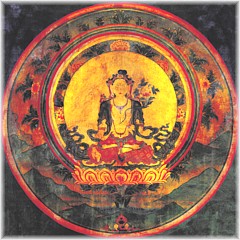White Tara: Difference between revisions
Jump to navigation
Jump to search
No edit summary |
No edit summary |
||
| Line 1: | Line 1: | ||
[[Image:JKW Tara med2.jpg|frame|The sacred image of White Tara, 'The Wish-Fulfilling Wheel' found in the empowerment room of [[Jamyang Khyentse Wangpo]]'s residence, [[The Joyful Grove of Immortal Accomplishment]]]] | [[Image:JKW Tara med2.jpg|frame|The sacred image of White Tara, 'The Wish-Fulfilling Wheel' found in the empowerment room of [[Jamyang Khyentse Wangpo]]'s residence, [[The Joyful Grove of Immortal Accomplishment]]]] | ||
'''White Tara''' (Skt. Sitatārā; Tib. སྒྲོལ་དཀར་, ''Drolkar''; [[Wyl.]] ''sgrol dkar'') — manifestations of [[Tara]], white in colour, associated with [[long life practice]]s | '''White Tara''' (Skt. Sitatārā; Tib. སྒྲོལ་དཀར་, ''Drolkar''; [[Wyl.]] ''sgrol dkar'') — manifestations of [[Tara]], white in colour, associated with [[long life practice]]s. The most well known is [[White Tara Wishfulfilling Wheel]] which is the main deity of the [[Chimé Pakmé Nyingtik]] [[sadhana]] for example. | ||
==External Links== | ==External Links== | ||
Revision as of 15:59, 12 December 2017

White Tara (Skt. Sitatārā; Tib. སྒྲོལ་དཀར་, Drolkar; Wyl. sgrol dkar) — manifestations of Tara, white in colour, associated with long life practices. The most well known is White Tara Wishfulfilling Wheel which is the main deity of the Chimé Pakmé Nyingtik sadhana for example.